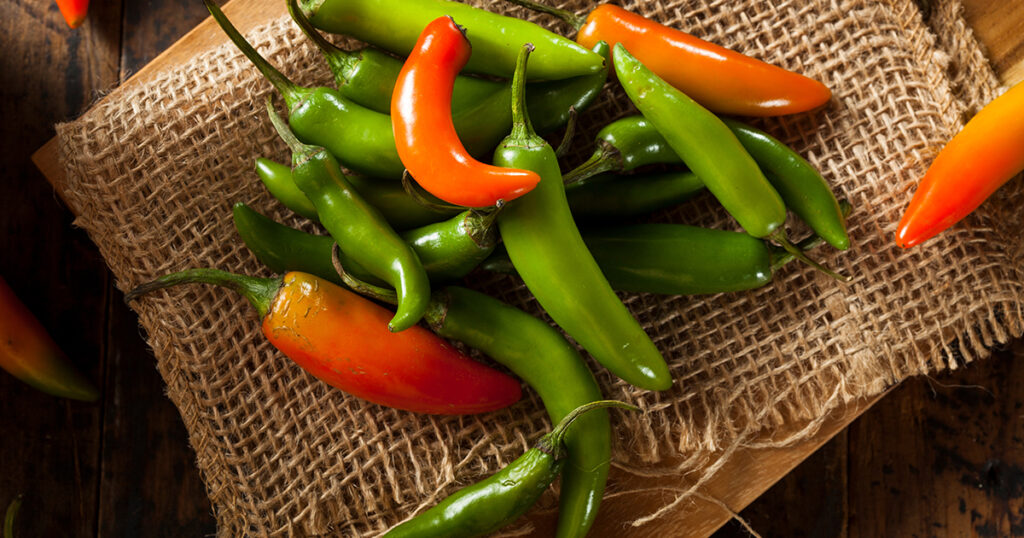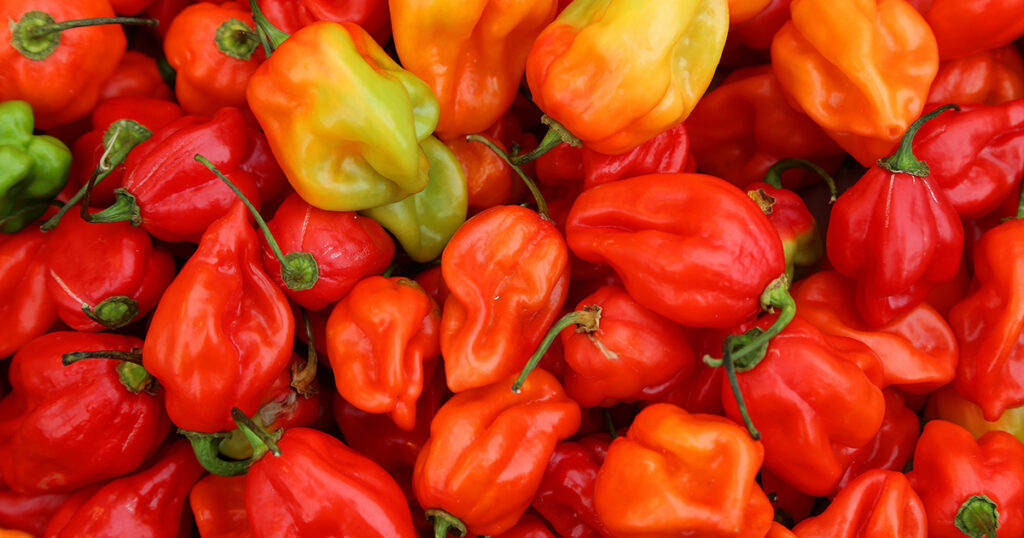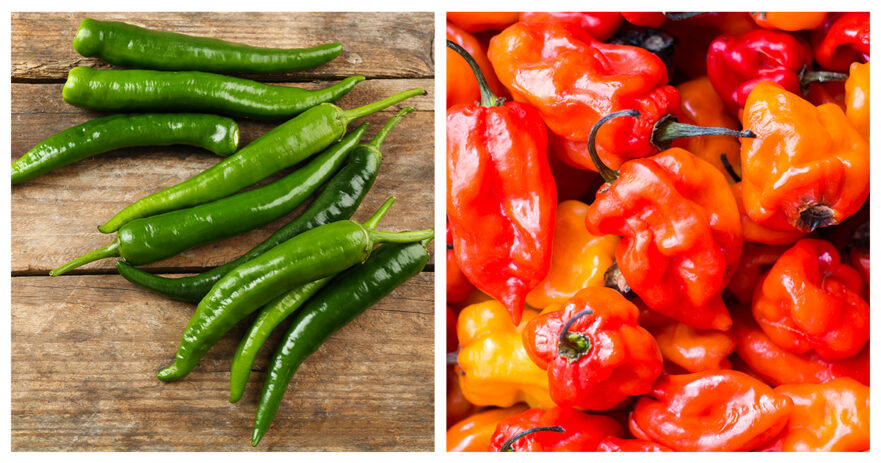Peppers have been a staple in cuisines around the world, bringing a burst of heat and flavor to a myriad of dishes. The serrano and habanero stand out for their distinctive taste and heat levels among the vast array of chili peppers. This article aims to delve deep into the world of these two popular chili peppers, contrasting their heat, flavors, culinary uses, and more. Whether you’re a fan of spicy foods or just curious about the nuances between different peppers, this guide will offer insights into when and why to use serrano or habanero in your recipes.
Table of contents
What are Serrano Peppers?

Serrano peppers are a celebrated variety of chili pepper that have their roots in the mountainous terrains of the Mexican states of Puebla and Hidalgo. These peppers are slender and predominantly green but can mature into red, purple, and yellow shades. The serrano pepper is often mistaken for the jalapeño due to its similar appearance, but a closer look and taste reveal notable differences.
When it comes to heat, the serrano pepper packs a punch. On the Scoville scale, which quantifies the spiciness of chili peppers, serranos fall between 10,000 to 23,000 Scoville Heat Units (SHU). This positions them hotter than jalapeños but milder compared to the fiery habanero peppers.
Culinary enthusiasts appreciate serrano peppers for their versatility. They provide a consistent spicy kick, whether chopped into salsas, blended into guacamole, or sliced atop various dishes.
Their heat levels can vary depending on factors like growing conditions, but they generally offer a medium burn that appeals to many. It’s crucial to approach them cautiously, especially when handling the seeds and membranes—the heat’s primary sources. And a word to the wise: never touch your eyes after working with these spicy gems!
What are Habanero Peppers?

Among the pantheon of chili peppers, the habanero pepper stands out as one of the hotter varieties. Tracing its origins to the Amazon basin, it later spread to Mexico and has since found its place in gardens and kitchens worldwide. Its heat and distinctive fruity flavor make it a favorite for those seeking a fiery thrill in their meals.
Measured on the Scoville scale, the habanero pepper boasts a rating ranging from a staggering 100,000 to 350,000 SHU. This places them substantially hotter than serrano peppers. But it’s not just about the intense heat; habaneros also offer a sweet, tangy taste, which introduces complexity to recipes that few other peppers can.
In terms of culinary applications, habanero peppers shine brightly. They are the stars in many hot sauces, especially the famed habanero hot sauce. Beyond sauces, they’re integral to numerous Caribbean dishes, where their heat and fruity flavor complement the region’s rich and diverse cuisine.
Their vibrant colors, ranging from orange to red and sometimes yellow, make them not just a treat for the palate but also for the eyes. When cooking with habaneros, always remember: a little goes a long way. Their extra hot nature demands respect, and, as with all hot peppers, one must avoid touching their face or eyes post-handling.
What are the Similarities Between Serrano Peppers and Habanero Peppers?
Both serrano peppers and habanero peppers hail from the rich tradition of chili peppers that grace cuisines worldwide. As natives of Central and South America, they have traveled far and wide, making their mark in various culinary landscapes.
Their primary function in cooking is to introduce heat and elevate the flavor of dishes. From fiery salsas to tantalizing main courses, these peppers have proven indispensable to chefs and home cooks alike. The versatility they offer ensures they remain a staple in many kitchens.
Regarding their heat profile, both peppers are classified as hot peppers. While their individual heat levels may differ, they both pack a punch that can be adjusted based on the inclusion or removal of their seeds.
Caution is the name of the game when working with both serrano peppers and habanero peppers. Their capsaicin content, responsible for the spiciness, can irritate, so it’s always advised not to touch your eyes after handling them.
What are the Differences Between Serrano Peppers and Habanero Peppers?
The world of chili peppers is vast, and within it, the serrano and habanero stand distinct in several aspects. Heat levels are perhaps the most glaring difference. Serrano peppers register between 10,000 to 23,000 SHU on the Scoville scale, whereas habanero peppers can soar from 100,000 to 350,000 SHU. This difference translates to a significantly spicier experience when biting into a habanero.
Flavor profiles further differentiate the two. While serrano peppers present a bright, spicy taste, habanero peppers weave in a delightful fruity flavor. This citrus-like undertone makes habaneros especially intriguing for recipes that benefit from a combination of sweet and spicy notes.
Appearance-wise, the two peppers are distinct. Serrano peppers are typically slender and green, whereas habanero peppers take on a more rounded shape and boast colors ranging from orange and red to yellow.
Lastly, their uses in cuisine vary. While serranos are versatile and find their way into various Mexican dishes, habaneros, with their unique flavor profile, are beloved in Caribbean cuisine and hot sauces.
FAQ about Serrano and Habanero
Can you substitute serrano for habanero?
While both serrano and habanero are hot peppers, they have different heat levels and flavor profiles. Substituting one for the other can affect a dish's overall taste and spiciness. Habanero peppers bring a more intense heat and a fruity flavor to recipes, whereas serrano peppers offer a cleaner, spicy taste. When substituting, it's crucial to adjust the quantity based on the desired heat and flavor.
Which is hotter, habanero serrano or jalapeño?
On the Scoville scale, habanero peppers rank the highest among the three, with ratings between 100,000 to 350,000 SHU. Serrano peppers come next, ranging from 10,000 to 23,000 SHU. Jalapeños are the mildest of the trio, with a Scoville rating between 2,500 to 8,000 SHU. Hence, habanero is the hottest, followed by serrano, and then jalapeño.
How many serrano peppers equal a habanero?
Given the significant heat difference between the two peppers, it's not a straightforward conversion. However, considering their Scoville ratings, you might need multiple serrano peppers to match the heat of a single habanero pepper. It can vary, but generally, 8 to 10 serrano peppers might equate to the heat of one habanero. Still, always adjust based on personal heat tolerance and the desired flavor.
What's hotter than a habanero?
There are several peppers hotter than a habanero. Notable mentions include the Ghost Pepper (Bhut Jolokia), Trinidad Scorpion, and the Carolina Reaper. The Carolina Reaper currently holds the title for the world's hottest pepper, with some variants reaching over 2 million SHU on the Scoville scale. These peppers are significantly hotter and should be used with extreme caution.
Why are serrano peppers not hot?
Serrano peppers are indeed hot, but their heat levels can vary depending on factors like growing conditions, maturity, and individual pepper variance. They might feel milder when compared to extremely hot peppers like habaneros or Ghost peppers. Removing the seeds and membranes from serrano peppers can also reduce their heat, as these parts contain the highest concentrations of capsaicin.

